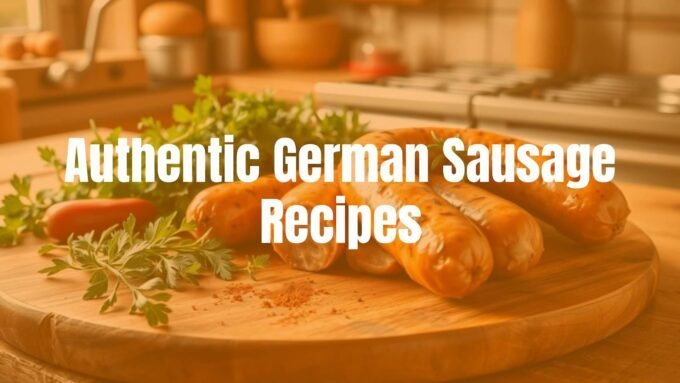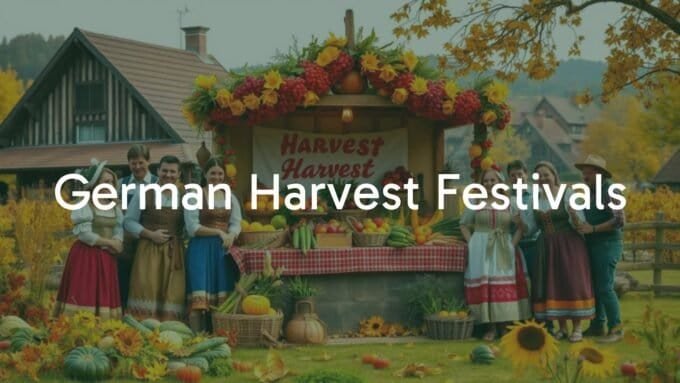Traditional German desserts are a wonderful journey through Germany’s long and varied food history. These sweets are known for their comforting, full flavors, use of fresh seasonal ingredients, and old-fashioned baking methods. Unlike some dessert styles that go heavy on sugary frostings or make everything extra sweet, German desserts usually focus on the flavors that come from fruits, nuts, and dairy, all with a gentle sweetness. These aren’t just food for after dinner-they are a big part of German daily life, especially during the popular afternoon ritual known as Kaffee und Kuchen (coffee and cake).

From thick, fruit-filled cakes to light cream pastries and spicy holiday cookies, classic German desserts cover a wide range of tastes and textures. Many recipes have been handed down for generations, showing the value families place on careful baking and top-quality ingredients. Whether you want a big, hearty cake for family or something light and fruity on a warm day, German sweets offer plenty of options and prove that traditional recipes can be simple but always delicious.
What Are Traditional German Desserts?
Traditional German desserts have a long history and play an important part in different regions and local celebrations. They aren’t just sugary treats; these desserts are often rich and comforting, and they’re meant to be enjoyed with coffee or tea, especially in the daily tradition of Kaffee und Kuchen. What stands out most is the way German desserts use real, simple ingredients and baking methods that are sometimes centuries old.
German sweets are often just sweet enough, letting the main ingredients speak for themselves. While some look fancy, lots of them are actually simple to make at home-even for beginners. This makes baking a big part of life in Germany, where people care more about flavor and texture than fancy icing or decorations.
Main Ingredients in German Sweets
German baking cupboards are usually stocked with basic ingredients that are used in most recipes: flour, sugar, butter, and eggs. Some ingredients, though, are especially popular in Germany. Quark is one; it is a creamy, soft cheese, a bit like thick yogurt, but with a tangy flavor. Quark is used in many German cheesecakes (Käsekuchen) and fruit-filled pastries, making them taste lighter and less sweet than American desserts. It is also a good source of protein.
Fruit is important-apples, plums (Zwetschgen), and berries like raspberries, strawberries, and currants are common in cakes, tarts, and sauces. Nuts, mainly almonds and hazelnuts, give crunch and flavor. Spices like cinnamon, cloves, and cardamom make a strong appearance, especially at Christmas time. Chocolate is also well-loved, used in cakes, cookies, and other treats.

Baking Methods and Equipment
German desserts often require specific ways of preparing dough and batter. Using yeast to make dough rise is a basic part of many recipes. This takes time and care to get the right soft and fluffy texture. While some jobs-like making a very thin strudel pastry-might seem hard at first, modern tips and tricks help home bakers manage them better.
There’s a big focus on mixing ingredients well, paying attention to temperatures, and giving doughs enough time to rest. Many classic recipes were created to be made with basic kitchen tools, so you don’t need lots of fancy equipment. Typical items like springform pans for cheesecakes or flat baking sheets for sheet cakes are widely used, showing that many German sweets are made to be shared with friends and family.
Regional Differences in German Desserts
German desserts change from region to region, using local fruits, traditions, and flavors. For example, Rote Grütze, a chilled berry dessert, comes from northern Germany, where berries grow well in summer. It’s usually served with cream or vanilla sauce.
South Germany, especially around the Black Forest, is famous for Schwarzwälder Kirschtorte (Black Forest Cake), which is made with cherries and cherry liqueur. In Bavaria, you might find Dampfnudeln-warm, fluffed yeast dumplings served with vanilla sauce-especially popular in colder months. These examples show that where you are in Germany changes what desserts you’ll see.

When Are Traditional German Desserts Served?
In Germany, desserts aren’t just for after dinner-they are enjoyed at different times throughout the day and year. Dessert can be part of everyday meals, but some kinds are made for special occasions, like holidays or festivals.
The most well-known time for dessert is during Kaffee und Kuchen, an afternoon treat when people have coffee and cake together. This is both a social and relaxing time, often spent visiting with friends or family. Besides this daily break, certain desserts are tied to special times of the year, like Christmas or Easter, becoming a big part of the celebration.
Holiday and Festival Sweets
Lots of German holidays have their own traditional desserts. At Christmas, you’ll find rich, fruit-filled breads like Stollen, and spicy cookies such as Lebkuchen and Zimtsterne (cinnamon stars). These are made ahead of time, filling homes with the smells of spices and baking.

Easter features its own cakes, such as the cute Lamb Cake (Osterlamm). In late summer, cakes using fresh plums (Zwetschgenkuchen) are in high demand, making the most of when the fruit is ripe.
Everyday German Desserts
German bakeries sell a big choice of cakes and pastries daily. These range from fruit tarts and crumb cakes to the well-loved Apfelkuchen (apple cake). Quark-filled pastries with fruit are also common for a light breakfast or snack.
Most German cakes are not very difficult to bake at home and are less sugary than in some other countries. Easy desserts like rice pudding (Milchreis) or fruit compotes are also popular, giving a sweet but gentle end to a meal or snack time.
Oktoberfest Desserts
Oktoberfest isn’t just about beer; it also features classic German sweets. Popular picks include Bienenstich (Bee Sting Cake), Schwarzwälder Kirschtorte (Black Forest Cake), and Apfelstrudel. These are warm, filling, and perfect for autumn. Sometimes, lighter desserts like Rote Grütze show up too. These treats are common at festival tents and homes during the weeks of Oktoberfest, which take place from mid-September to early October.
Best-Known Traditional German Cakes and Pastries
When people picture German desserts, they often think of special cakes and pastries that are famous both in Germany and abroad. Some are simple, while others are quite eye-catching. These desserts are important to celebrations, and each has its own background and fans.
Table: Famous German Cakes and Their Key Features
| Name | Main Ingredients | Description |
|---|---|---|
| Schwarzwälder Kirschtorte (Black Forest Cake) | Chocolate cake, cherries, Kirsch liqueur, whipped cream | Chocolate layers with cherries and cream, topped with chocolate shavings |
| Bienenstich (Bee Sting Cake) | Yeast dough, vanilla cream, caramelized almonds | Soft cake filled with cream and covered with crunchy, sweet almond topping |
| Käsekuchen (German Cheesecake) | Quark, eggs, sugar, short-crust base | Light, tangy cheesecake made with Quark instead of cream cheese |
| Baumkuchen (Tree Cake) | Batter (butter, eggs, sugar), chocolate glaze | Cake with many thin layers, looks like tree rings inside, usually chocolate coated |
| Donauwelle (Danube Wave Cake) | Marble cake batter, cherries, buttercream, chocolate glaze | Wavy layers of cake with cherries and cream, topped with chocolate |
| Apfelstrudel (Apple Strudel) | Thin pastry, apples, raisins, spices | Thin, flaky pastry rolled around spiced apple filling, often served warm |
| Zuckerkuchen (Sugar Cake) | Yeast dough, butter, sugar, almonds | Simple sheet cake with sugary, slightly crunchy top |

Favorite German Cookies and Christmas Sweets
The smell of spice and nuts coming from the oven is a sure sign the Christmas season is near in Germany. Making cookies is a family tradition, passed from one generation to the next, especially at holiday time. Some are enjoyed all year, but many are extra special around Christmas.
- Lebkuchen: German gingerbread, either soft or chewy; popular at Christmas, sometimes in heart shapes for fairs or gifts.
- Zimtsterne: Almond-based cinnamon cookies, cut into stars and glazed in white icing.
- Pfeffernüsse: Soft, round, spiced cookies, rolled in powdered sugar or glazed, eaten at Christmas.
- Spritzgebäck: Butter cookies made with a cookie press into different shapes; crisp and not too sweet.
- Stollen: Dense, fruit-filled bread with nuts and marzipan, heavily coated in powdered sugar; a Christmas staple.
Fruit-Based German Desserts
Fruits are at the heart of many German sweets-baked, made into compotes, or stirred into pastries. Recipes change by season, always using fruit at its best and freshest.
- Rote Grütze: A chilled, thick berry dessert, usually served with cream or vanilla sauce.
- Zwetschgenkuchen: Plum cake, made with a base of pastry and topped with rows of sliced plums.
- Apfelkuchen: Apple cake, with varieties ranging from crumb-topped (Streuselkuchen) to plain and moist.
- Fruit and Quark Pastries: Pastries filled with creamy Quark and topped with berries or stone fruit.
Other German Sweets: Beyond Cake and Cookies
There are plenty of German desserts that aren’t cakes or cookies. German sweets also include puddings, ice cream dishes, and special treats. These are especially good for lighter or refreshing desserts, often enjoyed in summer or as simple snacks.
- Dampfnudeln mit Vanillesauce: Soft yeast dumplings, steamed until fluffy and served with warm vanilla sauce.
- Spaghettieis: Vanilla ice cream pressed into noodles and topped with strawberry sauce and white chocolate, made to look like spaghetti.
- Eiskaffee: Coffee poured over scoops of vanilla ice cream and finished with whipped cream-a dessert drink.
- Windbeutel: Cream puffs, filled with whipped cream and usually dusted with powdered sugar.

Tips for Making German Desserts at Home
Trying your hand at German desserts can be fun and rewarding. Most recipes are designed for home bakers and you don’t need rare equipment. Key tips include:
- Use a kitchen scale for measuring ingredients-the results will be better.
- Springform pans are great for cheesecakes and tall cakes; baking trays are important for sheet cakes.
- For yeast doughs, a stand mixer helps, but a strong arm and bowl will do.
- A potato ricer or Spätzle maker is handy for Spaghettieis.
If you can’t find Quark, try making it yourself or use cottage cheese (blended) or thick Greek yogurt instead. For fruits, fresh in season is best, but frozen berries work for things like Rote Grütze. Use real cherry liqueur for Black Forest Cake if possible.
Storage matters: Refrigerate cakes with dairy or fruit so they stay fresh 3-5 days. Dryer cakes like Zuckerkuchen do fine on the counter for a day or two. Cookies keep in airtight containers at room temperature, and Stollen actually gets better after a few days and can be frozen for months.
FAQ: German Traditional Desserts
What makes a dessert “German”?
German desserts use a mix of typical ingredients (like apples, plums, nuts, and Quark), unique recipes, and have a big place in German everyday life. They often use yeast dough, have balanced sweetness, and are part of the tradition of Kaffee und Kuchen. The baking steps and techniques are often passed down through families.
How is German cheesecake different from New York cheesecake?
German cheesecake (Käsekuchen) uses Quark instead of cream cheese. This makes it lighter, fluffier, and a bit tangy, with a shortcrust base or sometimes no base, while New York style has a denser, creamy filling and usually a graham cracker crust. German versions are usually less sweet, letting the Quark flavor stand out.
Are German desserts less sweet than American ones?
Generally, yes. German desserts are usually less sugary. The goal is for the flavors of fruit, nuts, butter, or Quark to come through instead of just tasting sugar. They go well with coffee or tea, and you’ll notice a lot of flavor besides sweetness.












Leave a comment